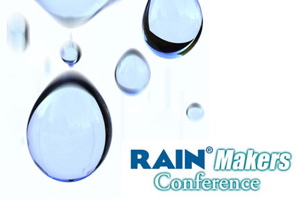Switching back to the event I attended this past Thursday evening, the RAIN Makers Conference, I wanted to pass along some of the insightful remarks made in the dinner keynote by my friend  Rich Karlgaard of Forbes. [Or as Guy Kawasaki, another friend and business partner, calls him, “Brother Rich.”]
Rich Karlgaard of Forbes. [Or as Guy Kawasaki, another friend and business partner, calls him, “Brother Rich.”]
“Since 2001, the global economy has added the equivalent of the whole U.S. economy,” Rich said, as he opened his talk with reference to macro trends. But, though the fundamentals are good, experts don’t agree that it’s a good economy, he said. And, when experts differ so much, something is up. “That something is we’re living in the greatest period of business model change — ever! Companies can come out of nowhere and knock out big players,” Karlgaard said. He referred to what McKinsey & Company calls the “topple rate” of established industry leaders, which tripled over a 20-year period according to their research.  One industry where this is happening is newspapers, with the stock of the New York Times, for example, at half what it was in 2002. Why is the industry in trouble? “Craig’s List is one reason,” he said, “a company with 23 employees.” He noted that McKinsey said the topple rate will triple again, and he gave some reasons why this volatility will stay with us. “The backside of Moore’s Law is the part that’s important. As performance increases, prices drop 30% a year. Suddenly, hundreds of millions more people can afford technology every year.” He also cited the example of Google bootstrapping its way early on, with the founders not taking equity investment but instead maxing out their credit cards.
One industry where this is happening is newspapers, with the stock of the New York Times, for example, at half what it was in 2002. Why is the industry in trouble? “Craig’s List is one reason,” he said, “a company with 23 employees.” He noted that McKinsey said the topple rate will triple again, and he gave some reasons why this volatility will stay with us. “The backside of Moore’s Law is the part that’s important. As performance increases, prices drop 30% a year. Suddenly, hundreds of millions more people can afford technology every year.” He also cited the example of Google bootstrapping its way early on, with the founders not taking equity investment but instead maxing out their credit cards.
Another reason is that the Internet is an amazing price arbitrage system. “Today, what two students can do on the ‘Net is more than what 10 analysts could do ten years ago. Now, anybody can determine what your margins are and come in well under your prices — maybe even 10% of them. Anyone can pick up your skirt.” Karlgaard gave an example of a 17-year-old kid he wrote about in his column recently who did such a thing and grossed $400,000 over three months, just by putting together a virtual team. He talked to his worldwide team members by phone only twice, doing everything else by email or IM. “Just another example,” Rich said, “of the Cheap Revolution at work.”
A final reason he said we’ll continue to see volatility is the amount of capital available. “Forbes even took capital recently — from Elevation Partners, where Bono is a partner!”  Read more about that in this Reuters story. [Another Elevation partner is Roger MacNamee, who has a rock band of his own: The Flying Other Brothers. Hey, I got the t-shirt! Right from Roger a few years ago…] Just how much money is out there? Rich laid it out: “About $1.5 trillion in risk capital is sloshing around looking to cause havoc. And about a half trillion of that is in the U.S. We’ll have volatility up the kazoo — get used to it.”
Read more about that in this Reuters story. [Another Elevation partner is Roger MacNamee, who has a rock band of his own: The Flying Other Brothers. Hey, I got the t-shirt! Right from Roger a few years ago…] Just how much money is out there? Rich laid it out: “About $1.5 trillion in risk capital is sloshing around looking to cause havoc. And about a half trillion of that is in the U.S. We’ll have volatility up the kazoo — get used to it.”
“What does all this have to do with you?” he asked the primarily Midwest audience of angels and business owners. “Well, cost becomes important.” He gave the example of companies such as Intel and HP that are lucky enough to have sales of $700,000 per employee — which may sound impressive, but it’s still not enough for these employees to really afford to live in Silicon Valley. “Now, Google, at $1.4 million in revenues per employee — they can!” His point: “The cost gap between the Valley and rural America is bigger than ever. But the knowledge gap isn’t.” Media access is not a problem anywhere, either, he pointed out — citing how it was much, much different when he grew up in Bismarck, ND. “All this portends well for a heartland revival,” Karlgaard said. “It’s a great time to be a nimble, small private company in a small or midsized town.” The macro trends favor disruption, he said. And the role of the U.S. in the global economy is “systems integrator to the world.”
How the Internet Is Affecting Forbes
Karlgaard also related some very interesting numbers about his employer, in addition to the recent equity investment by Elevation Partners. The surprising stats to many will be the growth metrics of Forbes.com.  “It’s growing at 70% year-over-year, and will have more ad revenue than the magazine by the end of 2007.” He said that’s what got Elevation Partners interested. “In the media business, as revenues double, valuation triples.” Forbes has very definitely become a global franchise. It’s seeing most of its growth on the Internet, and most of that growth is non-U.S. “But we’ll never give up on the magazine,” he said.
“It’s growing at 70% year-over-year, and will have more ad revenue than the magazine by the end of 2007.” He said that’s what got Elevation Partners interested. “In the media business, as revenues double, valuation triples.” Forbes has very definitely become a global franchise. It’s seeing most of its growth on the Internet, and most of that growth is non-U.S. “But we’ll never give up on the magazine,” he said.
Tags: Forbes, Rich Karlgaard, Bono, Elevation Partners
 It was a brilliant PR trick. Who couldn’t believe that Bono, known to be a real tech guy (and even a VC in his own right), might not show up at an event like this? And the guy looked exactly like him. He actually fooled a couple of CNet reporters. I had to tell them when we sat back down in the ballroom for the next session that I knew better: a firm I knew, Mindtouch, had hired an amazing Bono lookalike to hang out in its booth. What a stroke! VP Aaron Fulkerson, whom I know because he’s based in St. Paul, had previously told me the guy would show up. I asked him how he’d found him — hired him through a talent agency? “Nah,” he said, “I found him on the web.” And he said the guy actually knew Bono and had the same (real) first name: Paul.
It was a brilliant PR trick. Who couldn’t believe that Bono, known to be a real tech guy (and even a VC in his own right), might not show up at an event like this? And the guy looked exactly like him. He actually fooled a couple of CNet reporters. I had to tell them when we sat back down in the ballroom for the next session that I knew better: a firm I knew, Mindtouch, had hired an amazing Bono lookalike to hang out in its booth. What a stroke! VP Aaron Fulkerson, whom I know because he’s based in St. Paul, had previously told me the guy would show up. I asked him how he’d found him — hired him through a talent agency? “Nah,” he said, “I found him on the web.” And he said the guy actually knew Bono and had the same (real) first name: Paul. Rich Karlgaard of Forbes. [Or as Guy Kawasaki, another friend and business partner, calls him, “Brother Rich.”]
Rich Karlgaard of Forbes. [Or as Guy Kawasaki, another friend and business partner, calls him, “Brother Rich.”] One industry where this is happening is newspapers, with the stock of the New York Times, for example, at half what it was in 2002. Why is the industry in trouble? “Craig’s List is one reason,” he said, “a company with 23 employees.” He noted that McKinsey said the topple rate will triple again, and he gave some reasons why this volatility will stay with us. “The backside of Moore’s Law is the part that’s important. As performance increases, prices drop 30% a year. Suddenly, hundreds of millions more people can afford technology every year.” He also cited the example of Google bootstrapping its way early on, with the founders not taking equity investment but instead maxing out their credit cards.
One industry where this is happening is newspapers, with the stock of the New York Times, for example, at half what it was in 2002. Why is the industry in trouble? “Craig’s List is one reason,” he said, “a company with 23 employees.” He noted that McKinsey said the topple rate will triple again, and he gave some reasons why this volatility will stay with us. “The backside of Moore’s Law is the part that’s important. As performance increases, prices drop 30% a year. Suddenly, hundreds of millions more people can afford technology every year.” He also cited the example of Google bootstrapping its way early on, with the founders not taking equity investment but instead maxing out their credit cards.  Read more about that in
Read more about that in  “It’s growing at 70% year-over-year, and will have more ad revenue than the magazine by the end of 2007.” He said that’s what got Elevation Partners interested. “In the media business, as revenues double, valuation triples.” Forbes has very definitely become a global franchise. It’s seeing most of its growth on the Internet, and most of that growth is non-U.S. “But we’ll never give up on the magazine,” he said.
“It’s growing at 70% year-over-year, and will have more ad revenue than the magazine by the end of 2007.” He said that’s what got Elevation Partners interested. “In the media business, as revenues double, valuation triples.” Forbes has very definitely become a global franchise. It’s seeing most of its growth on the Internet, and most of that growth is non-U.S. “But we’ll never give up on the magazine,” he said.
Recent Comments